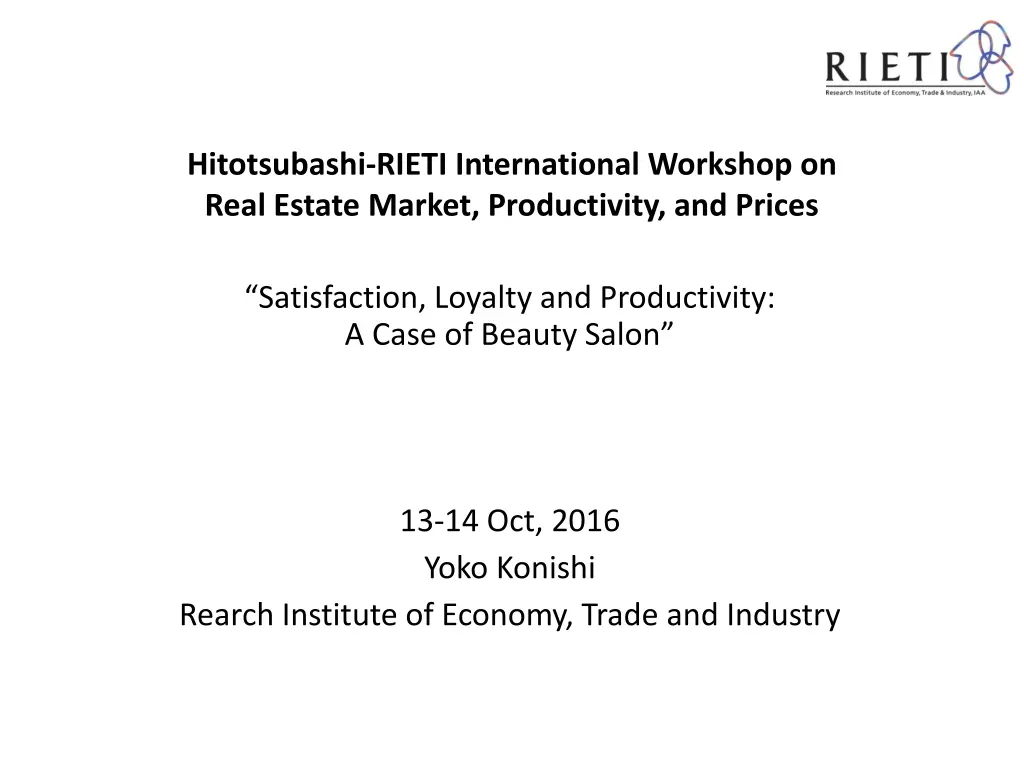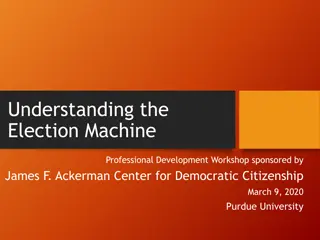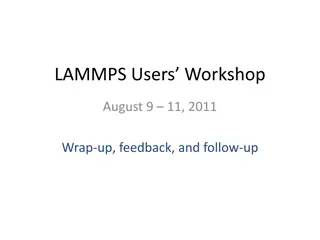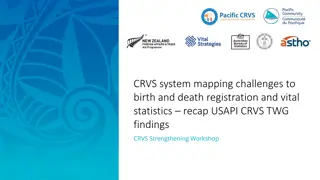
Exploring Customer Satisfaction and Loyalty in Japan's Beauty Industry
Delve into the factors influencing customer satisfaction and loyalty in Japan's service sector, particularly the beauty industry. Discover the impact of hairdresser skills, salon environment, and more on customer experiences and repeat visits.
Download Presentation

Please find below an Image/Link to download the presentation.
The content on the website is provided AS IS for your information and personal use only. It may not be sold, licensed, or shared on other websites without obtaining consent from the author. If you encounter any issues during the download, it is possible that the publisher has removed the file from their server.
You are allowed to download the files provided on this website for personal or commercial use, subject to the condition that they are used lawfully. All files are the property of their respective owners.
The content on the website is provided AS IS for your information and personal use only. It may not be sold, licensed, or shared on other websites without obtaining consent from the author.
E N D
Presentation Transcript
Hitotsubashi-RIETI International Workshop on Real Estate Market, Productivity, and Prices Satisfaction, Loyalty and Productivity: A Case of Beauty Salon 13-14 Oct, 2016 Yoko Konishi Rearch Institute of Economy, Trade and Industry
Outline of Todays Talk Purpose of this study Introduction (Overview of Japan s economy and beauty industry) Related researches about customer satisfaction and quality of service About a Hair salon and the Data set Model and Empirical Results Conclusion and Limitation of this research
What do hair salon and hairdressers provide customers? Do you like what features of hairdressers? Appearance -Hair style -Make up -Fashion Skill / Productivity -Speed -Good Design -Good Finishing Communication skill -Conversation -Counseling One answer is that they provide services and create customer satisfaction. If customers were satisfied with the hair dresser, they will revisit the salon.
Object and Purpose of This Study Find impact factors of demand (satisfaction) function. Find reasons of customer s loyalty or life time value gain. measure the effects of skill of hair dressers and the environment of hair salon on customers satisfactions. We challenged to reproduce the experience space of customers at hair salon to investigate what causes them to come back to hairsalon.
Overview of Japans Economy (1) Service industry s share of GDP and employees are not small compared with manufacturing industry. Source: National Accounts supplied by the Cabinet Office --The narrow definition s service industry includes EATING AND DRINKING PLACES, HEALTH CARE AND WELFARE , EDUCATION, COMPOUND SERVICES and PERSONAL SERVISES. As evident from these figures, overall economic activity can no longer be explained simply in terms of the manufacturing industry. The service sector is extremely important due to its presence in the overall economy and magnitude.
Overview of Japans Economy (2) The number of establishments 270000 220000 176000 1st 2nd 3rd 55000 30000 9th 25th Hair salon & barber shop Drinking Places Real estate agencies Restaurants Convenience stores Establishments, sales and number of employees by scale of employees Establishments Sales (milion yen) Number of employees Establishments which have four or less employees account for over 95%. Number of employees Barber shop Hair salon Barber Shop Hair Salon Barber Shop Hair Salon 1-4 persons 89400 125809 345067 659225 162109 212480 5-9 persons 2938 12057 73187 375147 17646 75882 10-19 persons 286 3040 14870 225915 3436 38321 20-29 persons 32 349 3243 41823 774 8037 30-49 persons 22 154 4920 34041 844 5609 50 persons and more 8 78 5452 34978 884 8563 Total 92686 141487 446739 1371129 185693 348892 * The hair salon that we used in the empirical analysis is located in 10-19 persons segment. Source: Economic Census for Business Activity, by METI (2012)
Classification of Service Industries Customer Interaction / contacts LOW HIGH capital intensive Service Factory Service Shop services Airline, Trucking, Hospitals, Restaurants, Hotels, Resorts and Auto and other repair Recreation services Degree of labor Mass Service Professional Service intensity law firms, accounting Commercial firms, bankings, retailing, doctors, teachers, wholesaling, hair salon and other schools beauty services labor intensive HIGH HIGH services Schmenner (1986) breaks service industry down into four patterns by using the degree of labor intensity and the customer interactions. The labor intensity denotes that the ratio of labor cost against value-added. The customer interaction means that the frequency of service providers contact to customers during the services.
Difficulties of Quality Evaluations for Goods and Services most of goods most of services Difficult to Evaluate Easy to Evaluate Television Repair Medical Diagnosis Auto Repair Child Care Jewelry Furniture Restaurant Meals Legal Services Root Canal House Clothing Haircuts Automobiles Vacation High in Experience Qualities High in Search Qualities High in Credence Qualities Zeithaml (1981) indicates the evaluation processes of qualities are differ between consumer goods and services by using the three attributes. Goods and Services are allocated high in search qualities, high in experience qual. and high in credence qual. along a continuum of evaluation ranging from easy evaluation to difficult evaluation
As discussion above, marketing and management researchers have recognized hair salon (personal services) as conducive business to study. On the other hand, in economics research, hair salon and barber shop are cited as example of industry which have very simple structure. For example, it is regarded that consumers decide a shop by whether the shop is proximity or not. Gr nroos (1988) defined the quality of services as the technical aspect ( what service is provided) and the functional aspect ( how the service is provided). Technical quality: professionalism and skill Functional quality: attitudes and behavior , accessibility and flexibility, reliability and trustworthiness, recovery and reputation
Stress Factors in Hair salon If the hair salon understands the value and preferences of functional quality for each customer and then they can provide comfortable environment, it will lead to raise of customer loyalty and to get service differentiation from other hair salons. scissors and razor near the face Distance between hairdressers Shampoo in the unnatural posture the line of sight of the others, the conversation with the first meeting people
About the hair salon (1) Opened in Osaka city, Japan since July 23rd, 2003. We collect the data from 2003 to 2010 (2048 working days). 16500 customers visit during the period. Female customers account for about 90%. They have seven hairdressers and four assistant staffs. 10chairs with mirror and 6 shampoo chairs. Open hour: Tue-Fri 11am 8pm, Sat, Sun & holidays 10am-7pm. Main services are Hair cut, hair coloring and permanent wave. The three services share of total number of treatments are 87%, also the three services yield 90% of the total sales. The hair salon has sold around 90.0milion yen annually from 2004 to 2009.
id age distance visit date date hairdersser services price discount total payment 1 21 13.80874 2003/7/23 Wed 2 COLOR 5500 2750 2750 1 21 13.80874 2003/7/23 Wed 2 CUT 4000 2000 2000 1 22 13.80874 2003/12/29 Mon 2 SHAMPOO 500 250 250 1 22 13.80874 2003/12/29 Mon 2 SET 2000 1000 1000 1 22 13.80874 2004/5/15 Sat 2 COLOR 5250 2625 2625 1 22 13.80874 2004/5/15 Sat 2 CUT 4200 2100 2100 1 22 13.80874 2004/7/10 Sat 2 CUT 4200 2100 2100 1 22 13.80874 2004/7/10 Sat 2 COLOR 5250 2625 2625 2 24 5.6 2003/7/23 Wed 3 COLOR 6000 3000 3000 2 24 5.6 2003/7/23 Wed 3 CUT 4000 2000 2000 2 24 5.6 2003/7/23 Wed 3 hair_goods 2500 0 2500 2 24 5.6 2003/8/3 Sun 3 SET 4000 1200 2800 2 24 5.6 2003/9/9 Tue 3 CUT 4000 1200 2800 2 24 5.6 2003/9/9 Tue 3 COLOR 6000 1800 4200 2 24 5.6 2003/10/31 Fri 3 COLOR 6000 1800 4200 2 24 5.6 2003/10/31 Fri 3 CUT 4500 1350 3150 2 24 5.6 2003/12/27 Sat 3 CUT 4000 1200 2800 2 24 5.6 2003/12/27 Sat 3 COLOR 6000 1800 4200 2 24 5.6 2004/2/14 Sat 3 COLOR 6000 1800 4200 2 24 5.6 2004/2/14 Sat 3 CUT 4000 1200 2800 2 24 5.6 2004/3/27 Sat 3 COLOR 6000 1800 4200 2 24 5.6 2004/3/27 Sat 3 SET 1000 300 700 2 24 5.6 2004/5/18 Tue 3 CUT 4200 1260 2940 2 24 5.6 2004/5/18 Tue 3 COLOR 6300 1890 4410 2 24 5.6 2004/5/29 Sat 3 SET 3675 1102 2573 2 24 5.6 2004/6/17 Thu 3 Exte 7875 0 7875 2 24 5.6 2004/7/18 Sun 3 COLOR 6300 1890 4410 2 24 5.6 2004/7/18 Sun 3 CUT 4200 1260 2940
About the hair salon (2) Summary statistics of customer s age Histogram of number of revisits Year Number of Customer Mean Median Std. Dev. Min Max 2003 2,114 26.4 25 7.7 11 77 2004 3,100 26.3 25 7.8 12 75 2005 2,558 26.7 25 7.4 11 75 2006 1,767 27.0 26 7.2 11 75 2007 1,951 27.4 26 7.4 10 77 2008 1,877 27.1 26 7.1 13 75 2009 1,156 27.2 26 7.6 10 74 2010 348 25.9 25 6.9 12 65 Total 14,871 --- --- --- --- --- Summary statistics of distance # of Customer Mean Std. Dev. Median 75percentiles 95percentiles min. max. 12,799 14.6 48.0 7.3 12.5 33.1 0.98 1264 Number of non-revisit customers account for 44.3% of sum of customers.
About the hair salon (3) Number of Customers and the Average Customer Spend by segments # of customers average customer The customers who visited at the hair salon 4 or less accounts 71%. As the number of total visits increases, the average customer spends are getting higher. We might say the loyalty is growing. Customer Segmentation total visit times (Share) spend non revisit customer 1 time 5903 (44.3%) 7,710 regular customer 2-4 times 3560 (26.7%) 8,068 loyal customer 5-10 times 2216 (16.6%) 8,924 super loyal customer 11 and more 1645 (12.3%) 9,460 Total 13,324 8,223 Duration and Average Customer Spend by kinds of services duration of non revisit (day) Obs. mean median std.dev. Among the three combination of services, intervals of revisiting are similar. On the other hand, the average customer spends of hair cut is only about one-third of other two combinations. Hair Cut 15,531 86.0 61 107.9 Hair Coloring & Cut 17,686 86.8 69 85.7 Parmanet Wave & Cut 7,304 89.4 64 99.8 average customer spend (yen) Obs. mean median std.dev. Hair Cut 19,096 4380.6 3780 1769.4 Hair Coloring & Cut 22,540 11281.1 10920 2973.7 Parmanet Wave & Cut 10,101 11585.6 10950 3626.3
Empirical Model (1) Our main research concern is the customer s revisit behavior. We have excess zeros (non-revisit and no-purchase) observation, that is, both revisit and repurchase outcomes are bounded. Most famous censored dependent variable model is a Tobit model, it assumes that the decision of revisit the hair salon and how much purchase in the next visit are explained by same factors. Cragg (1971) allows us to specify the separate equations for revisit and consumption behavior. The hurdle model concerns that the unbounded outcomes are over jump a hurdle. The double hurdle can be expressed by combination of probit and tobit estimator such as = ?? ? + ?1,? ,?? = ?? ? + ?2,? ?? ?1,? ?2,? ~ ? 0 0 ,1 0 ?2 0 , where ??? + ?1,?and ??? + ?2,?represent the perticipation equation and the quantity equation.
, The first hurdle is defined by the latent variable ?? > 0 0. ??= 1 ?? ?? ??= 0 ?? ?? The second hurdle is given by = ??? ?? ,0 , ?? . consequently, outcome variable ?? is defined as ??= ???? The hurdle model s log-likelihood function is log ? ??? 1 ? ???,??? ??? ?(???) +1 ?? ??? ? = + ?? . ? ??=0 ??>0 We adopt two outcomes, first one is total amount of purchase of each customer by each day (hereafter, total payment), another is cumulative sum of total payment divide by cumulative sum of number of visit for each customer by each day (hereafter, average payment).
Data Description variable name Description expected sign label age age of customers on the last visit day + or - age^2/1000 (age*age/1000) + or - gender customer's gender, male=0 and female=1 + or - distance distance between customer's residence and the hair salon - discount rate (each service' price/total amount of payment)*100 + or - When customers make an appointment with appointment (dummy vars) + Loyalty a specific hairdresser=1, otherwise=0 hair product (dummy vars) purchasing hair product =1, otherwise=0 + hair cut (dummy vars) taken hair cut=1, otherwise=0 + or - hair color with hair cut taken hair color with hair cut=1, otherwise=0 + or - (dummy vars) permanent wave with hair cut taken permanent wave with hair cut=1, otherwise=0 + or - (dummy vars) hair cut, color and permanent purchase hair product=1, otherwise=0 + or - wave (dummy vars) hair salon's congestion hairdresser's congestion # of customers (daily)/90 percentile of # of customers (yearly) + or - Functional Quality count # of customers for each hairdresser, daily based data + or - hairdresser's fatigue log of (ith customer/total # of customer) for each hairdresser, - estimate 90percentile of # of customers for each hairdresser, skill / capacity of hairdressers + Technical Quality annual based data hairdressers_1-11 (dummy vars) hairdressers in charge for the last visit + or - spring_dummy March, April and May=1, otherwise=0 + or - summer_dummy June, July and August=1, otherwise=0 + or - fall_dummy September, October and November=1, otherwise=0 + or - winter_dummy December, January and February=1, otherwise=0 + or - Notes: We specially focus on the shaded areas' results.
Estimation Results (selected variables) total payment average payment variables expected sign Label consumption participation consumption participation 1,190.713*** (205.906) 1,556.871*** (59.139) 434.795*** (114.539) 0.044 1.647*** (0.029) 0.068** (0.031) -0.251*** (0.058) 0.006*** 490.900*** (182.247) 1,503.096*** (30.915) 176.284*** (56.523) 0.779 1.325*** (0.017) 0.146*** (0.024) -0.126*** (0.042) 0.003** + appointment Loyalty + hair product hair salon's congestion + or - hair dresser's Functional Quality - congestion (3.672) (0.002) (1.804) (0.001) hair dresser's fatigue -158.626*** (32.129) -0.075*** 0.003* -91.484*** (16.172) -0.067*** (0.013) - Technical Quality skill/capacity of hairdressers 67.012*** (5.950) 0.003* (0.002) 35.499*** (2.969) 0.007*** (0.001) +
Findings (1) The customer who makes an appointment with their favorite hairdresser will come back to the salon and purchase more than the customer who does not. The coefficients of hair products are significantly positive. The customer who has higher loyalty will revisit with higher probability and they will spend more money in the next visit. hairsalon scongestion are significantly negative in the participation regressions, it suggests that the salon's impression is impulsive, then it discourage willingness of customer s revisit. On the contrary, the purchase models have positive coefficients of hair salon s congestion. It indicates that the customers who revisit multiple time prefer the active salon.
Findings (2) hairdresser s congestion are insignificant in the purchase regressions and significantly positive in the revisit probability regressions. hairdresser'sfatigue is examined by log of the receipt number of each hairdresser. We assume when the receipt number is larger, the hairdresser is probably getting tired. We found the coefficients are significantly negative. The variable may capture of hairdressers conditions, feeling and some atmosphere. It may be memorable for customers.
Findings (3) We control the time variant skill/experiences of hairdressers by hairdresser s skill and capacity . The hairdresser's capacity variable is proxy for each hairdresser's skill or productivity year by year. We observe the positive coefficients of hairdressers skill in all models. We can say the skill or productivity of hairdressers contribute to raise the probability of revisit, total amount of sales and the loyalty.
Conclusion and Limitation of this study (1) In this study, we challenged to reproduce the experience space of customers at hair salon by using the customer behavioral variables, loyalty data, the hairdresser s skill and hair salon s atmosphere or environment in addition to demographic variables. These new adopted variables influence the customer's attitude toward the revisiting behavior and purchase decisions at the salon. We found that customer s purchase behaviors are more sensitive against the salon's atmosphere, congestion, and hairdressers' skills.
Conclusion and Limitation of this study (2) This research was conducted in one hair salon in Japan, thus may not be generalizable to other hair salons. Therefore, more salons need to be investigated. It is also suggested that other related factors of service quality such as internal marketing, detailed hairdresser s quality and skill, peer review among workers must be helpful to measure their productivity and quality.






















